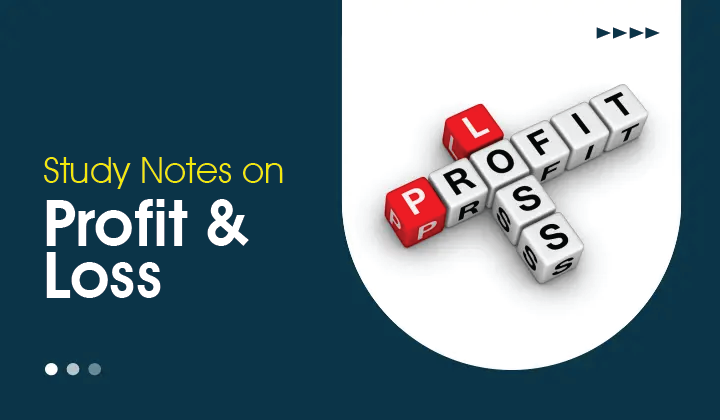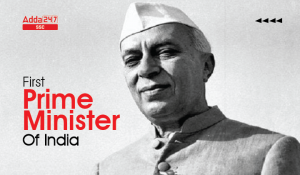Profit and Loss: Quantitative Aptitude is one of the most important topics and it is asked in almost every government recruitment exam. Generally, the questions that are questions asked are related to basic concepts and formulas. Generally, the questions are questions asked related to basic concepts and formulas of Profit and Loss. To score full marks on this topic, you must practice enough questions and get acquainted with the concept behind it. We have covered important notes and questions related to Profit and Loss.
Profit and Loss
The chapter on Profit and Loss contains a lot of concepts that the candidates should be aware of to solve the questions based on them. Some of the basic definitions that the candidates should be aware of to perform well in competitive exams are provided below.
Profit(P): The amount gained by selling a product with more than its cost price.
Loss(L): The amount the seller incurs after selling the product less than its cost price is mentioned as a loss.
Cost Price (CP): The price at which an article is purchased is called its cost price (C.P.)
Selling Price (SP): The price at which the article is sold is called its selling price (S.P.)
Profit and Loss Formula
- If the cost price (C.P.) of the article is equal to the selling price (S.P.), then there is no loss or gain.
- If the selling price (S.P.) > cost price (C.P.), then the seller is said to have a profit or gain. Gain/Profit = S.P. – C.P.
- If the cost price (C.P.) > selling price (S.P.), then the seller is said to have a loss. Loss = C.P. – S.P.
- Gain % = (Gain × 100)/(C.P.)
- Loss% = (Loss × 100)/(C.P.)
- When the selling price and gain percent are given: C.P.= (100/(100+Gain%))×S.P.
- When the cost and gain percent is given: S.P=((100+Gain%)/100)×C.P.
- When the cost and loss percent is given: S.P.=((100-Loss%)/100)×C.P
- When the selling price and loss percent are given: C.P=(100/(100-Loss%))×S.P
- If a man buys x items for Rs. y and sells z items for Rs. w, then the gain or loss percent made by him is given by: (xw/zy-1)×100%
- If the cost price of m articles is equal to the selling price of n articles, then % gain or loss = ((m – n)/n) × 100 (If m > n, it is % gain, and if m < n, it is % loss)
- If an article is sold at a price S.P.₁, then % gain or % loss is x and if it is sold at a price S.P.₂, then % gain or % loss is y. If the cost price of the article is C.P., then
(S.P₁)/(100+x)=(S.P₂)/(100+y)=(C.P.)/100=(S.P_1-S.P_2)/(x-y); Where x or y is –ve, if it indicates a loss, otherwise it is +ve. - If ‘A’ sells an article to ‘B’ at a gain of m% and ‘B’ sells it to ‘C’ at a gain of n%. If ‘C’ pays Rs. z for it to ‘B’ then the cost price for ‘A’ is
z X 100/(100+m) X 100/ (100+n)
[2S – {S X 100/(100+x) + S X 100/(100-y)}] X 100/{S X 100/(100+x) + S X 100/(100-y)}
16. When two different articles are sold at the same selling price getting a gain of x% on the first and a loss of x% on the second, then the overall loss in the transaction is given by (x/10)² %. (Note: In such questions, there is always a loss.)
17. A merchant uses faulty measures and sells his goods at a gain/loss of x%. The overall % gain/loss(g) is given by (100+g)/(100+x)=(True measure)/(Faulty measure). (Note: If the merchant sells his goods at cost price, then x = 0.)
18. A merchant uses y% less weight/length and sells his goods at a gain/loss of x%. The overall % gain/loss is given by [((y+x)/(100-y))×100]%.
19. A person buys two items for Rs. A and sells one at a loss of f% and the other at a gain of g%. If each item was sold at the same price, then
(a) The cost price of the item sold at a loss
{A X (100+g)}/{(100-f) X (100+g)}
(b) The cost price of the item sold at a gain
{A X (100-f)}/{(100-f) X (100+g)}
20. If two successive discounts on an article are m% and n%, respectively, then a single discount equivalent to the two successive discounts will be (m+n-mn/100)%
21. If three successive discounts on an article are l%, m%, and n%, respectively, then a single discount equivalent to the three successive discounts will be
l + m + n – (lm + mn + ln)/100 + lmn/10000
18. A shopkeeper sells an item at Rs. z after giving a discount of d% on the labeled price. Had he not given the discount, he would have earned a profit of p% on the cost price. The cost price of each item is given by z {100/(100-d)}{100/(100+p)}
Profit and Loss Questions
Here are some profit and loss examples that will help candidates understand the profit and loss properly and according to the exam point of view. Candidates must try to solve the profit and loss examples given below and verify their answers.
Solution: Let the cost price of goods be Rs 100.
Gain = 20%
Therefore, Selling price = Rs 120
Discount = 25%
Marked Price = (100/100-25)x120 = Rs. 160 = 60% more
Solution: If a trader professes to sell his goods at cost price, but uses false weights, then
Gain% = {Error/(True value – Error) x 100}%
In the given question, Error = 1000 – 850 = 150
Thus, Gain% = {150/(1000 – 150) x 100}% = 17 11/17%
Selling Price at 10% loss = 90x/100
Selling Price at 15% gain = 115x/100
Thus, according to the problem,
115x/100 – 90x/100 = 40
x = Rs.160
CP of 20 articles = 20
Given that the cost price of 20 articles is the same as the selling price of x articles
=> Selling price (SP) of x articles = 20 (Equation 2)
Given that Profit = 25%
(SP-CP/CP)=25/100=1/4 ( Equation 3)
Substituting equations 1 and 2 in equation 3,
(20-x)/x=1/4
80-4x=x
5x=80
x=80/5=16
Ans (B)
Solution: Let C.P.= Rs. 100. Then, Profit = Rs. 320, S.P. = Rs. 420.
New C.P. = 125% of Rs. 100 = Rs. 125
New S.P. = Rs. 420.
Profit = Rs. (420 – 125) = Rs. 295.
Required percentage = (295/420 x 100)% = 1475/21 % = 70% (approximately).



 Reasoning Topics Asked in SSC CGL Exam L...
Reasoning Topics Asked in SSC CGL Exam L...
 Free Study Material for SSC CGL 2025, Do...
Free Study Material for SSC CGL 2025, Do...
 Pandit Jawaharlal Nehru, First Prime Min...
Pandit Jawaharlal Nehru, First Prime Min...


